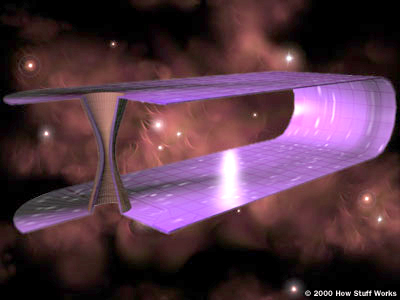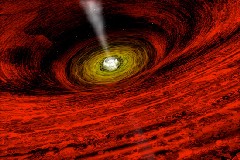|
|
Ana Sayfa |
|
|
|
|
|
|
|
|
|
|
|
Zaman yolculuğu hakkında ek bilgiler |
|
|
Çetin BAL: Time Travel Theory |
|
|
Muzaffer Kınalı: Zamanda yolculuk |
|
|
Zaman Makinesi yapılabilir mi? |
|
|
Uğur Özkanbaş: Philadelphia Experiment |
|
|
UFO Technology |
|
|
Zaman Deneyleri |
|
|
Geçmişe Yolculuk |
|
|
Rainbow Project |
|
|
Zamanda Yolculuk-1 |
|
|
Gravitik Sevk |
|
Time Travel Research Center © 2005 Cetin BAL - GSM:+90 05366063183 -Turkey/Denizli | |
|
Wormholes Thorne believes there could be another type of tunnel-like structure existing in the universe that could be used for a time travel portal. Wormholes, also called Einstein-Rosen Bridges, are considered to have the most potential for time travel if they do exist. Not only could they allow us to travel through time, they could allow us to travel many light-years from Earth in only a fraction of the amount of time that it would take us with conventional space travel methods. Wormholes are considered possible based on Einstein's theory of relativity, which states that any mass curves spacetime. To understand this curvature, think about two people holding a bed sheet up and stretching that sheet tight. If one person were to place a baseball on the bed sheet, the weight of the baseball would roll to the middle of the sheet and cause the sheet to curve at that point. Now, if a marble were placed on the edge of the same bed sheet it would travel down toward the baseball because of the curve.
Imagining space as a curved two-dimensional plane, wormholes like this could be formed by two masses applying enough force on spacetime to create a tunnel connecting distant points in the universe.
In this example, space is depicted as a two-dimensional plane rather than the four dimensions that actually make up spacetime. Imagine that this sheet is folded over leaving a space between the top and bottom. Placing the baseball on the top side will cause a curvature to form. If an equal mass were placed on the bottom part of the sheet at a point that corresponds with the location of the baseball on the top, the second mass would eventually meet with the baseball. This is similar to how wormholes are likely to form. In space, masses that place pressure on different parts of the universe could eventually come together to form a tunnel, this is a wormhole. We could then travel from Earth to another galaxy and back relatively quickly (within a lifetime). For instance, let's picture a scenario in which we would want to travel to Sirius, a star that's seen in the Canis Major constellation just below Orion. Sirius is about 9 light-years from Earth, which is about 54 trillion miles (90 trillion km). Obviously, this distance would be far too long for space travelers to traverse and return in time to tell us about what they saw there. So far, the farthest people have traveled into space is to the moon, which is only about 248,548 miles (about 400,000 km) away from Earth. If we could find a wormhole that connected us to the space around Sirius, then we could cut the time considerably by avoiding the trillions of miles that we would have to cross with traditional space travel. So how does all this relate to time travel? As we discussed earlier, the theory of relativity states that as the velocity of an object nears the speed of light, time slows down. Scientists have discovered that even at the speeds of the space shuttle, astronauts can travel a few nanoseconds into the future. To understand this, picture two people, person 1 and person 2. Person 1 stays on Earth, while person 2 takes off in a spacecraft. At takeoff, both of their watches are in perfect sync. The closer person 2's spacecraft travels to the speed of light, the slower time will pass for person 2 (relative to person 1). If person 2 travels for just a few hours at 50 percent the speed of light and returns to Earth, it will be obvious to both people that person 1 has aged much faster than person 2. This difference in aging is because time passed much faster for person 1 than person 2, who was traveling closer to the speed of light. Many years might have passed for person 1, while person 2 experienced a time lapse of just a few hours. Read more about this twin paradox in How Special Relativity Works. If wormholes could be discovered, it might allow us to travel to the past as well as the future. Here's how it would work. Let's say the mouth of the wormhole is portable. Then person 2 in the example above who traveled at 50 percent of light speed into space for a few hours could carry one wormhole mouth into space, while the mouth at the opposite end of the wormhole would stay with person 1 on Earth. The two people would continue to see one another as person 2 traveled into space. When person 2 returns to Earth a few hours later, a few years may have passed for person 1. Now, when person 1 looks through the wormhole that traveled into space, that person will see him or herself at a younger age, the age he or she was when person 2 launched into space. The cool thing about it is that the older person 1 would be able to step into the past by entering the wormhole, while the younger person 1 could step into the future. Black Holes, Wormholes and Cosmic Strings Rotating black holes Wormholes Cosmic strings Rotating Black Holes
When stars that are more than four times the mass of our sun <http://www.howstuffworks.com/sun.htm> reach the end of their life and have burned up all of their fuel, they collapse under the pressure of their own weight. This implosion creates "black" holes, which have gravitational fields so strong that light cannot even escape. Anything that comes in contact with a black hole's event horizon will be sucked in. The event horizon is the boundary of a black hole at which nothing can escape. You can think of the shape of a black hole as similar to an ice cream cone. It is large on top and tapers into a point, called a singularity. At the singularity, the laws of physics cease to exist and all matter is crushed beyond recognition. This kind of non-rotating black hole is called a Schwarzschild black hole, named after the German astronomer Karl Schwarzschild. Another type of black hole, called a Kerr hole, is also theoretically possible. Kerr holes are rotating black holes that could be used as portals for time travel or travel to parallel universes. In 1963, New Zealand mathematician Roy Kerr proposed the first realistic theory for a rotating black hole. In his theory, dying stars would collapse into a rotating ring of neutrons which would produce sufficient centrifugal force to prevent the formation of a singularity. Since the black hole would not have a singularity, Kerr believed it would be safe to enter it without being crushed by the infinite amount of gravitational force at its center. If Kerr holes do exist, it might be possible to pass through them and exit out of a "white" hole. A white hole would have the reverse action of a black hole. So, instead of pulling everything into its gravitational force, it would use some sort of exotic matter with negative energy to push everything out and away from it. These white holes would be our way to enter other times or other worlds. Given the little we know about black holes, Kerr holes may possibly exist. However, physicist Kip Thorne of the California Institute of Technology believes that the laws of physics prevent such a formation. He says there is no such way to enter and exit a black hole, and that anything attempting to enter a black hole will be sucked in and destroyed before it even reaches the singularity. Copyright © 1998-2001 Howstuffworks, Inc. All rights reserved. Hiçbir yazı/ resim izinsiz olarak kullanılamaz!! Telif hakları uyarınca bu bir suçtur..! Tüm hakları Çetin BAL' a aittir. Kaynak gösterilmek şartıyla siteden alıntı yapılabilir. The Time Machine Project © 2005 Cetin BAL - GSM:+90 05366063183 -Turkiye/Denizli
Ana Sayfa /index /Roket bilimi / Time Travel Technology /Ziyaretçi Defteri /UFO Technology/Duyuru |


